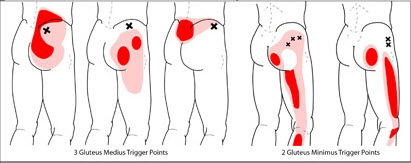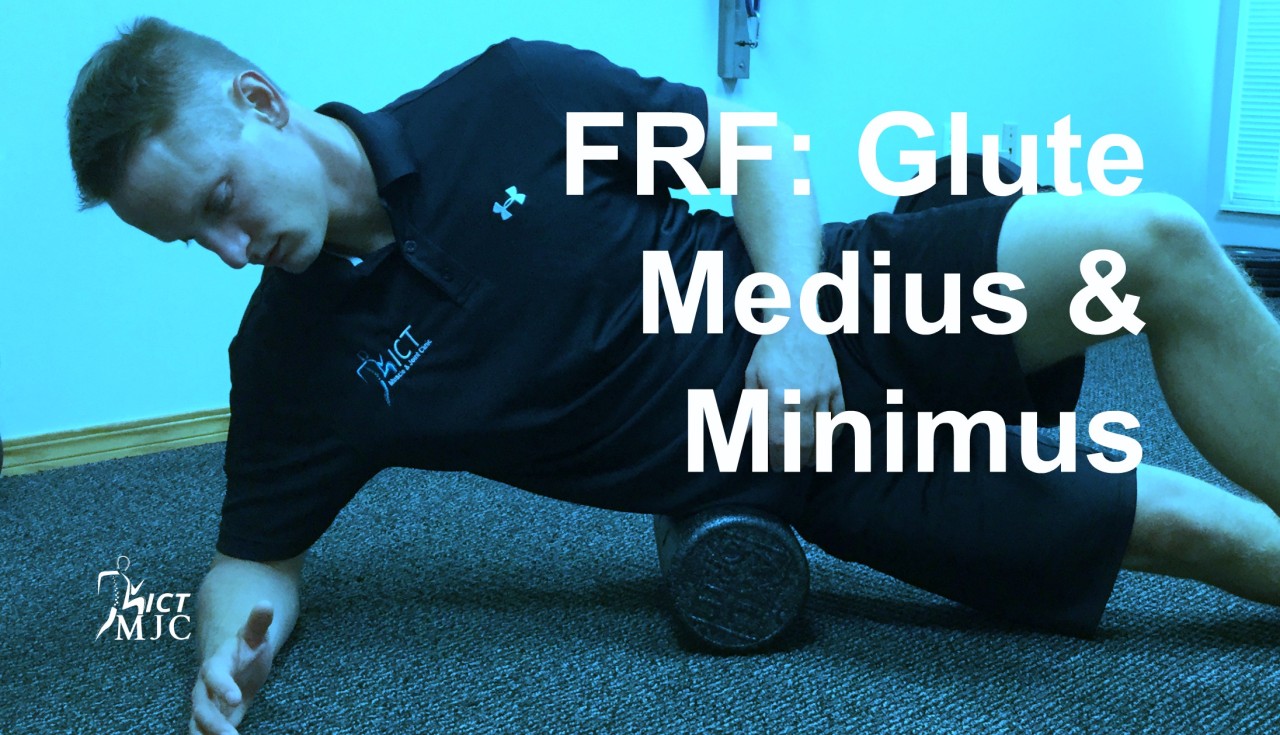Foam Rolling Friday: Glute Medius & Minimus
Improper hip motion is oftentimes a culprit to low back pain and knee pain. Interestingly, the area where we experience pain is regularly not the source of pain. When the glute medius and glute minimus become problematic they can refer pain down the leg (mimicking a disc herniation), and to the SI joint. These muscles become dysfunctional due to lack of use. Stating this, you would think working on activating these muscles alone would be sufficient, but recent research indicates that combining soft tissue therapy with rehab/exercise training, adds greater benefit then either alone.¹
The Functional Anatomy
The hip is the second most mobile joint in the body. It is considered a ball and socket joint, which is a fancy way of stating it has a huge range of motion. When considering range of motion (ROM), it is important to categorize ROM into two groups: passive ROM, and active ROM. I would argue PROM is slightly less important than AROM, however they are honestly two sides of the same coin. My justification for stating AROM is slightly more important than PROM is that most individuals will never fully utilize the ROM in their hips in any given day. As a result, the brain becomes bored and disuse or atrophy sets in. Over time and with lack of use, the brain attempts to stabilize unstable structures, thus producing trigger points. The referral pattern for glute medius and minimus trigger points are shown below.

Take a second to feel your hips. Start by pressing between the top of your pelvis and to your hip bone (as shown in the video). The glute medius lays directly over the glute minimus. Both fibers run almost straight down from the top of your pelvis to your hip. If you take your time, I can almost promise you, there will be tightness somewhere along these muscles. If you rush, you might miss it.
These tight myofascial areas are locations where your brain does not feel stabile. Foam rolling this area of your hips can have a huge impact on improving the overall neurological activity between the brain and these muscles, allowing you to better access their potentials. Foam rolling the hips have been shown to improve ROM within the hips² for this reason.
These two muscles are functionally important in helping to stabilize the pelvis, by keeping it level when the foot is in contact with the ground (i.e. left foot down uses left glute medius and minimus to stabilize the pelvis). This maintains a neutral position along with the opposite quadratus lumborum, a deep back muscle. During the swing phase (leg off the ground) of gait, these muscles still function, however they may fire differently. Both muscles have fibers that attach to the front of the hip and back of the hip allowing them to rotate the hip internally and externally respectively. If the stance side leg is weak and allows drifting of the pelvis to that side, then the swinging leg has to "swing" out around the stance leg, creating an altered gait pattern. While running, this is noted as a crossover gait. Taking care of your tissue quality via foam rolling and exercising are two great ways to help improve your hip mechanics and decrease associated pain.
The Why
From a pure pain standpoint, foam rolling these muscles can aid in decreased trigger point activity, which are shown above. If you have pain in the red highlighted areas, try foam rolling the designated "X" marks. If you palpate or foam roll in these areas and do not feel tightness, ropiness, or your specific referral pain, then this might not be the right area for you to foam roll; no harm, no foul. The tissue quality surrounding your hip can be your best friend or your worst nightmare. Literally, I have known people whose sleep benefited by foam rolling the hip.
From a performance standpoint, foam rolling the hip can increase the amount of neurological awareness to these muscular areas, thus improving the potential AROM within the designated hip. Remember, AROM is somewhat more important than PROM. The glute medius and minimus muscular areas can get very tight limiting your speed, power, and performance. The key to improving mechanics and decreasing pain is about waking up the right areas and calming down the wrong areas. Just remember, it's all in the hips!
References
Cheatham S, Kolber M, Cain M, Lee M. The effects of self-myofascial release using a foam roll or roller massager on joint range of motion, muscle recovery, and performance: A Systemic Review. IJSPT. 2015 Nov. 10(6): 827-838. PubMed PMCID: PMC4637917
Salom-Moreno J, Ayuso-Casado B, Tamaral-Costa B, Sánchez-Milá Z, Fernández-de-las-Peñas C, Alburquerque-Sendín F. Trigger Point Dry Needling and Proprioceptive Exercises for the Management of Chronic Ankle Instability: A Randomized Clinical Trial. Evid Based Complement Alternat Med. 2015 April 30: 790209. PubMed PMCID: PMC4430654
About the author
Dr. Keith Sparks is an award-winning chiropractor, functional medicine expert, and the co-founder of ICT Muscle & Joint Clinic. Dr. Sparks’ emphasis of care originated within the fields of rehabilitation, soft-tissue therapies, and chiropractic. To date, he has brought this unique combination of skills into union with functional medicine. The sole purpose of intertwining these distinct skills, knowledge, and services is to provide incomparable care to his local community. Dr. Keith Sparks is often seen in the Wichita, KS community speaking at business events and teaching health and performance classes.
